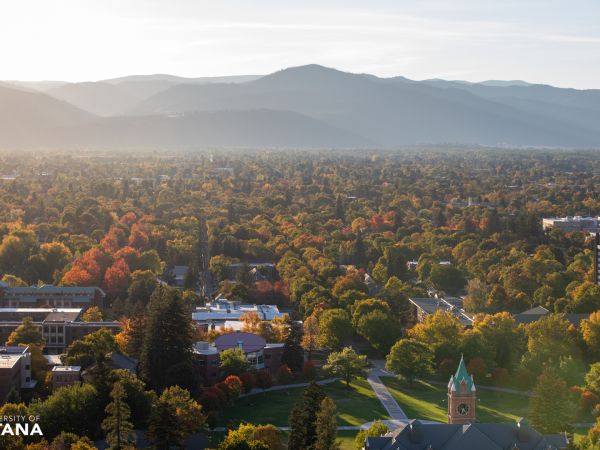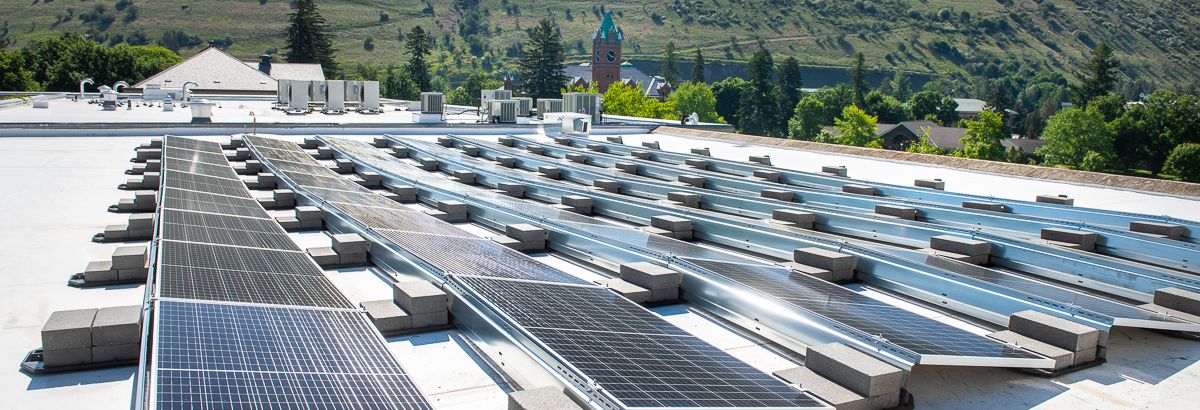
UM Sustainability Map
The Ñý¼§Ö±²¥ is home to many sustainability features throughout campus. Follow along and click the links below to learn more about our initiatives as you take yourself on a tour of campus!
1. Begin at the , located on the north end of the Oval. This building is home to the Environmental Studies Department. It is one of the oldest buildings on campus, named after Jeannette Rankin, who was the first woman elected to the U.S. Congress in 1916.

2. Head east towards , the State of Montana's interpretive site located on the north side of Main Hall and south of the Natural Sciences Building. The Ñý¼§Ö±²¥ is actually the State Arboretum. We have many trees and plants from all over North America featured on our campus. Learn more about the State Arboretum here.
3. Near the Root, directly to the north, you will see a native pollinator garden and greenhouse. UM has been certified with Bee Campus USA since 2024, and we take pride in our native pollinator gardens. UC Gardens takes care of the garden beds inside and outside of the UC, and volunteers help take care of the native pollinator garden you are looking at.
4. The University Center has always been a supporter of sustainability on campus. In 2021, the UC converted all of their lights to LED lights. The UC is also home to our compost  pilot program, where you can find composting in multiple locations inside the building. The UC also has bins for recycling glass, the only place where you can recycle glass on campus. You can also visit the ASUM Suites in the UC, where you can get involved in clubs supporting sustainability and conservation on campus. Outside the west doors of the UC, you will see covered bike parking. This bike parking was funded by the Kless Sustainability Fund. Students pay a $9.00 sustainability fee each semester. That money goes into the Kless Fund, and Ñý¼§Ö±²¥ have the opportunity to apply for funding for sustainability projects on campus. Learn more about the Kless Fund and its projects here.
pilot program, where you can find composting in multiple locations inside the building. The UC also has bins for recycling glass, the only place where you can recycle glass on campus. You can also visit the ASUM Suites in the UC, where you can get involved in clubs supporting sustainability and conservation on campus. Outside the west doors of the UC, you will see covered bike parking. This bike parking was funded by the Kless Sustainability Fund. Students pay a $9.00 sustainability fee each semester. That money goes into the Kless Fund, and Ñý¼§Ö±²¥ have the opportunity to apply for funding for sustainability projects on campus. Learn more about the Kless Fund and its projects here.
5. From the University Center, head north towards the large "smokestack-looking" building. This is commonly known as the steam plant, or heating plant. This building is currently being converted into a Combined Heat and Power Plant, where giant jet engines inside will generate both steam and electricity off of natural gas. We will use the steam to heat our buildings and convert it to energy for electricity. Although natural gas isn't usually referred to as "sustainable," we see this plant as a big win. It will reduce our emissions by around 1/3, and will remove us almost fully from having to rely on Northwestern Energy. Learn more about the CHP here.
Combined Heat and Power Plant, where giant jet engines inside will generate both steam and electricity off of natural gas. We will use the steam to heat our buildings and convert it to energy for electricity. Although natural gas isn't usually referred to as "sustainable," we see this plant as a big win. It will reduce our emissions by around 1/3, and will remove us almost fully from having to rely on Northwestern Energy. Learn more about the CHP here.
6. From the CHP, head west past McGill Hall and enter the Inside the main foyer area, you might be able to observe our "All in the Hall" garbage bins. The education building is one of a few buildings that have been a part of this new program. The purpose of All in the Hall is to get rid of all options to throw away trash, except in locations where multi-stream recycling is nearby. The Phyllis J Washington Education Building has removed all garbage cans from offices and classrooms, replacing them with All in the Hall bins in each hallway. This means that when someone goes to toss something, they have easy access to recycling and compost, rather than choosing to throw it in the garbage as a convenient option. Eck Hall, Main Hall, the Mansfield Library, the UC, this building, and a couple of other buildings have all received new bins for our All in the Hall program. More buildings are slated to be included in fall 2024. Learn more about All in the Hall here.
have been a part of this new program. The purpose of All in the Hall is to get rid of all options to throw away trash, except in locations where multi-stream recycling is nearby. The Phyllis J Washington Education Building has removed all garbage cans from offices and classrooms, replacing them with All in the Hall bins in each hallway. This means that when someone goes to toss something, they have easy access to recycling and compost, rather than choosing to throw it in the garbage as a convenient option. Eck Hall, Main Hall, the Mansfield Library, the UC, this building, and a couple of other buildings have all received new bins for our All in the Hall program. More buildings are slated to be included in fall 2024. Learn more about All in the Hall here.
7. Continue north and enter the . Similar to the UC, Campus Recreation has worked hard to be an example of sustainability. Campus Recreation has solar panels on their  building, skylights above their gym to reduce light needs, electric vehicle charging, LED lights, and more. Campus Recreation consistently applies for Kless grants to lessen their carbon footprint. Campus Recreation is currently carbon-neutral. Learn more about Campus Rec's sustainability efforts here. Campus Recreation is also home to the Outdoor Program, where you can rent gear for your next adventure. The Outdoor Program takes Ñý¼§Ö±²¥ and freshmen on wilderness experiences and teaches sustainable recreation practices, including "Leave No Trace" and how to be Bear Smart in the outdoors.
building, skylights above their gym to reduce light needs, electric vehicle charging, LED lights, and more. Campus Recreation consistently applies for Kless grants to lessen their carbon footprint. Campus Recreation is currently carbon-neutral. Learn more about Campus Rec's sustainability efforts here. Campus Recreation is also home to the Outdoor Program, where you can rent gear for your next adventure. The Outdoor Program takes Ñý¼§Ö±²¥ and freshmen on wilderness experiences and teaches sustainable recreation practices, including "Leave No Trace" and how to be Bear Smart in the outdoors.
8. Outside Campus Recreation is a wind energy-powered lamp post in memory of Sonny Kless. Sonny helped champion a revolving energy loan fund back in 2009. In 2010, he tragically passed away in a plane accident. This fund was renamed the Kless Sustainability Fund in his name, and the lamp post was installed in his honor.
9. From Campus Recreation, head southwest towards the . This is the bus depot for all of the UDASH buses. Students can ride the UDASH bus to commute to campus each day without having to drive their car. UDASH is working towards an all-electric fleet, with 5/8 buses currently electric. ASUM Transportation, who runs the UDASH bus program, hires and trains student employees to drive the UDASH buses. With four fixed routes and special event shuttles, UDASH helps over 2,000 Ñý¼§Ö±²¥ get to school each day. UDASH is a free-fare bus and is open to the public. Mountain Line, the city bus system, is also free. ASUM Transportation also offers subsidized bike rentals for Ñý¼§Ö±²¥, trip planning assistance, and more. Learn more about transportation on campus here.
drive their car. UDASH is working towards an all-electric fleet, with 5/8 buses currently electric. ASUM Transportation, who runs the UDASH bus program, hires and trains student employees to drive the UDASH buses. With four fixed routes and special event shuttles, UDASH helps over 2,000 Ñý¼§Ö±²¥ get to school each day. UDASH is a free-fare bus and is open to the public. Mountain Line, the city bus system, is also free. ASUM Transportation also offers subsidized bike rentals for Ñý¼§Ö±²¥, trip planning assistance, and more. Learn more about transportation on campus here.
10. Head south from the Transit Hub towards the Oval. You will pass the Eck Hall is one of the few buildings on campus that has solar panels. Solar energy is an excellent alternative energy source, but it is difficult to install here in Montana. Montana does not get the same sunny days as other states, and we use far more electricity than can be generated from small solar panels. But, we know that solar can help us reduce our overall footprint and we continue to analyze potential buildings for solar projects. Eck Hall is slated to add additional solar panels, funded by the Kless Fund.
11. Across the Oval from Eck Hall, you can This building is  LEED Platinum, meaning it was built to the highest of sustainability standards. All new buildings on campus are now required to be at least LEED Silver. The Payne Native American Center features wood pillars pulled from the local river, sustainable building materials, low-flush toilets, and more. Learn more about this beautiful building here. Outside the PNAC, the Ethnobotany Garden features plants, shrubs, and grasses of the Rocky Mountain West.
LEED Platinum, meaning it was built to the highest of sustainability standards. All new buildings on campus are now required to be at least LEED Silver. The Payne Native American Center features wood pillars pulled from the local river, sustainable building materials, low-flush toilets, and more. Learn more about this beautiful building here. Outside the PNAC, the Ethnobotany Garden features plants, shrubs, and grasses of the Rocky Mountain West.
12. West from the PNAC, you will see the newly constructed Lodge Dining Center. Completed before the Fall semester of 2024, the Lodge recently was announced as LEED Gold certified. Much of the produce served at the Lodge is sustainably sourced from the campus Iron Griz Gardens. Student employees spend much of the summer working in the gardens, planting, and harvesting crops to feed other UM Ñý¼§Ö±²¥. Additionally, the Lodge's "green" features include the use of low-emitting materials, infrastructure for green vehicles, and sensitive land protection. Learn more about the Lodge here!
spend much of the summer working in the gardens, planting, and harvesting crops to feed other UM Ñý¼§Ö±²¥. Additionally, the Lodge's "green" features include the use of low-emitting materials, infrastructure for green vehicles, and sensitive land protection. Learn more about the Lodge here!
